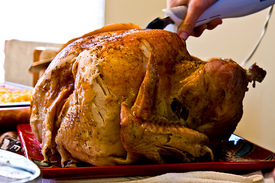Let's talk turkey! What part of the bird is healthiest?

It isn't like in the movie "Meet the Parents"...You can choose a thigh or breast without fear!
photo by flickr user 7D Kenny
When my family gathers for Thanksgiving, my mom always prepares the turkey. She has a gifted ability to make turkey deliciously moist, never dried out. When she goes to carve it, she always divides it by dark and white meat, since she and my sister love the white. My dad and I grab for the dark meat.
Since I always seem to justify my unhealthy habits, you should not be surprised that I wanted to justify the dark meat lovers out there!
It is the great divide for many of you: Which meat do you choose and why? If you like the white meat, go ahead and enjoy, but I just have to tell you, you aren't saving that many calories.
In fact, dark meat is actually more nutritious, even if it does have a few more calories. According to a New York Times article from November, 2007, Turkey-Which is Healthier, White or Dark meat, really, the author Anahad O' Connor concludes:
"Many people choose white meat over dark because of its lower caloric content. But according to the Department of Agriculture, an ounce of boneless, skinless turkey breast contains about 46 calories and 1 gram of fat, compared with roughly 50 calories and 2 grams of fat for an ounce of boneless, skinless thigh.
But dark meat has its benefits. Compared with white meat, it contains more iron, zinc, riboflavin, thiamine and vitamins B6 and B12. Both have less fat than most cuts of red meat, so you can't go wrong either way."
No need to reach for what you think is the healthiest. Reach for the meat you like! Now that we have talked turkey, go ahead and just enjoy! Give thanks for choices!
Eva Johnson is an ACE (American Council on Exercise) certified personal trainer who is looking forward to making leftover dark turkey meat and mayo sandwiches. She will follow that meal up with some bootcamp workouts. She lives in chaos with her husband and two boys. To see her complete blog about how to stay sane and in shape in the real world, visit www.fitnessbyeva.com.


Comments
Rork Kuick
Tue, Nov 22, 2011 : 5:13 p.m.
No reference here or in the article pointed to the calorie data. And I had a hard time finding that data from USDA. No references or numerical data for the vitamins or minerals either - we expect the difference is small, but who knows. This is reporting in the 2010's. Here's info from U of Illinois Extension (<a href="http://urbanext.illinois.edu/turkey/nutrition.cfm)" rel='nofollow'>http://urbanext.illinois.edu/turkey/nutrition.cfm)</a> for not-quite-so-microscopic (3.5 oz) portions: Breast with skin 194 cal, 8 grams fat Breast without skin 161 cal, 4g fat. Wing w/skin 238 cal, 13g. Leg w/skin 213, 11. Dark meat w/skin 232, 13. Dark meat wo/skin 192, 8. So without skin dark vs. breast there was 31 cal/3.5 oz difference. More than claimed by O'Connor. About 4 g (36 cal) more fat. I eat turkey so little that I am not concerned though. I do not doubt the dark vs breast difference may depend on details of bird size, feeding history, and cooking details. The one bird per year I slaughter is greasier than the average store-bought animal. Top round of white-tail deer gives 129 cal/ 3oz, 14.7 cal from fat (about 1.6 g) says Livestrong.com. Impressive. When I fill out health questionnaires, I never know how to report my deer consumption, which is ten times my cow+pig consumption.